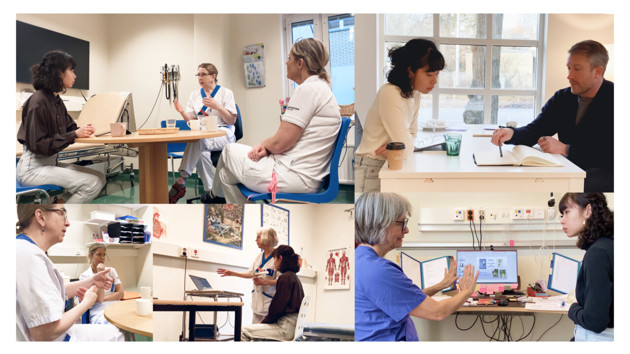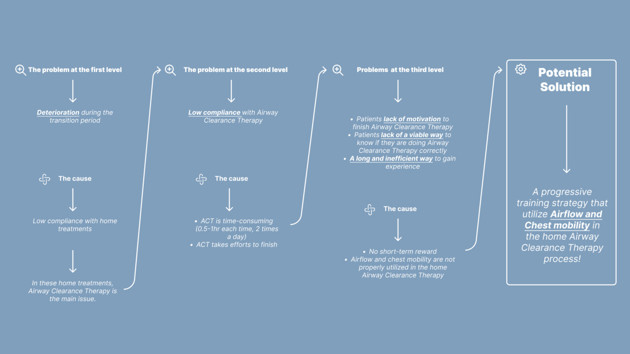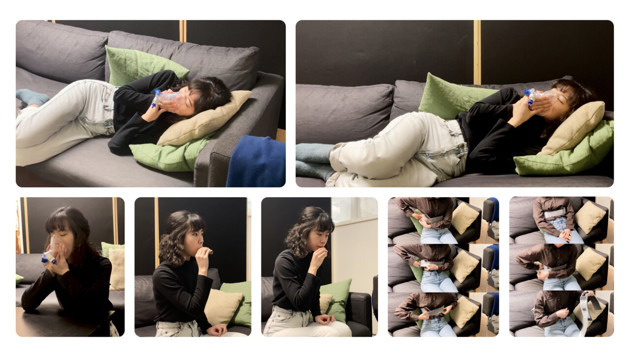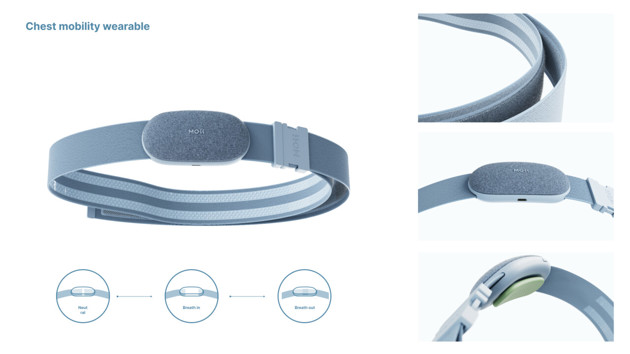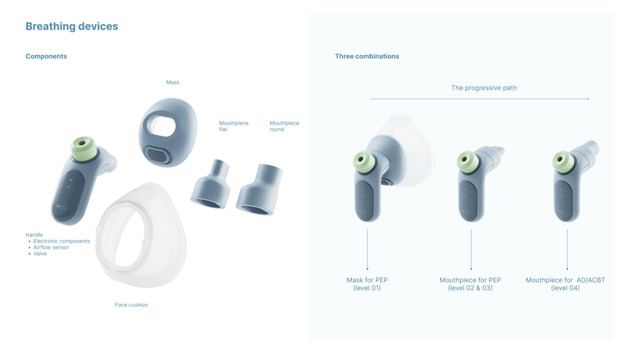UID23 | Yuchen Lan – Grad Project Presentation
Moii
Cystic fibrosis is a genetic disease that primarily affects the function of the lungs. It creates a thick layer of mucus that can lead to air trapping, infection, and lung damage. There is no cure for cystic fibrosis. Patients need daily treatment to slow lung failure to prolong life. Approximately 70,000 people worldwide have cystic fibrosis. One in every 3,000 newborns is diagnosed. Moii is a strategy for adolescent patients to facilitate the completion of daily ACT to prevent deterioration during the "transition" period (age 12/13 - young adult). It trains the patient in airflow control and chest mobility. A progressive approach is designed to help patients gain experience and gradually free them from cumbersome equipment. This approach empowers them and gradually gives them the ability to perform ACT without restrictions, thus gaining more freedom.
Project Information
Cystic Fibrosis (CF) is a genetic disease that mainly affects the function of the lungs. The lungs of CF patients are colonized and infected by bacteria from an early age; most of the patients are diagnosed at birth. There is no cure for Cystic Fibrosis; patients rely on treatments to remove secretions from their lungs, thereby reducing infection to prolong their lives. In this project, I targeted patients' "transition" (usually 12/13 years old, when patients started to manage their treatments themselves - young adulthood) to prevent patients from experiencing lung deterioration.
Method
In this project, I dug deeper into user research. I have been fortunate to receive help in this project, which included the Swedish Cystic Fibrosis Association(RFCF), CF Center Gothenburg, CF Center Uppsala, Fonden Citronfjärilen, Genia APP, and 28 patients and families, which helped me to learn deeply about the disease, the social environment, conditions, and even related policy. With the Britta-Stina Nordensteds scholarship, I also conducted field trips to Stockholm, Uppsala, and Gothenburg, as well as visited local patients in Umeå.
My entry point was the concept of the "transition period," when patients started to manage their treatment, and the hazards of a period of deterioration during this period. I then conducted research to find the most significant cause of the deterioration. After the field research, I concluded that the biggest problem was the low completion rate of Airway Clearance Therapy(ACT) in the patient's daily treatment. So I continued researching why patients do not complete Airway Clearance Therapy. I have summarized the following reasons: ACT is time-consuming and requires energy. When daily activities and ACT conflict, this time-consuming and energy-consuming activity will be the first to be dropped. Second, patients are not motivated to perform home ACT, especially children. ACT can help clear sputum and help delay lung failure as well as prolong life, but it has no visible short-term results. So some patients say: I don't know why I want to do Airway Clearance Therapy.I feel like I'm wasting my time. Moreover, patients do not know whether they are doing ACT in the right way or not at home. There is no valid way to measure ACT's efficiency in the home environment. Finally, the learning cycle is too long. Patients learn the Airway Clearance techniques at the CF Center, then go home and practice. After six months, when they need regular body check-ups in the CF Center, they show their physiotherapists how well they did. If they don't do it correctly, the CF Physical Therapist corrects them and the process repeats again. This means that they usually have a minimum learning cycle of 6 months.
After analyzing and summarizing the problem, I searched for possible solutions. I noticed two critical factors to completing the ACT, which were not being utilized properly: airflow and chest mobility. Airflow control is the capability needed to apply various Airway Clearance technologies correctly, while fine chest mobility is the key to fine airflow control. For teenagers, "finding the optimal airflow," which the physiotherapist always emphasizes, is too abstract, and it is difficult for them to find the best airflow by imagination or feeling without experience. Regarding chest mobility, patients are guided by the physiotherapist at the CF Center. However, there is no guidance at home.
Result
Moii is a progressive Airway Clearance Therapy training kit for adolescent Cystic Fibrosis patients. It is a strategy that helps them improve motivation, trains them to complete the home Airway Clearance Therapy effectively, and gradually frees them from cumbersome equipment.
This kit contains three parts: Modular breathing devices that detect airflow, chest mobility wearable, and an APP. There are three combination for breathing devices. Patients start by adapting to Positive Expiratory Pressure (PEP) technique and gradually switch to Autogenic Drainage(AD) or The Active Cycle of Breathing Technique(ACBT) that relies less on equipment, with the ultimate goal of training them to complete ACT without restrictions. Chest mobility wearable detects chest movement and calculates patients’ breathing muscle strength. Muscle strength is also digitized and visualized so that patients can see short-term results for a sense of accomplishment. The APP serves as a feedback method. It receives data from the breathing device and wearable, gives real-time feedback and guidance while the patient performs ACT, and visualizes the efficiency and breathing pattern afterward. In this way, the patient is assured that the ACT is done correctly and efficiently.The app can be used as a communication tool as well. For example, when the patient's respiratory pattern becomes abnormalthe, Moii app can pass it to the CF Team. The CF Team can use this as a basis for changing the treatment plan or taking actions to prevent deterioration.
UID23 | Yuchen Lan – Grad Project Presentation

